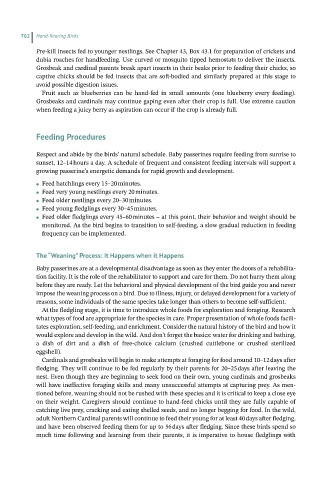Page 759 - Hand rearing birds second
P. 759
762 Hand-Rearing Birds
Pre‐kill insects fed to younger nestlings. See Chapter 43, Box 43.1 for preparation of crickets and
dubia roaches for handfeeding. Use curved or mosquito tipped hemostats to deliver the insects.
Grosbeak and cardinal parents break apart insects in their beaks prior to feeding their chicks, so
captive chicks should be fed insects that are soft‐bodied and similarly prepared at this stage to
avoid possible digestion issues.
Fruit such as blueberries can be hand‐fed in small amounts (one blueberry every feeding).
Grosbeaks and cardinals may continue gaping even after their crop is full. Use extreme caution
when feeding a juicy berry as aspiration can occur if the crop is already full.
FeedingProcedures
Respect and abide by the birds’ natural schedule. Baby passerines require feeding from sunrise to
sunset, 12–14 hours a day. A schedule of frequent and consistent feeding intervals will support a
growing passerine’s energetic demands for rapid growth and development.
Feed hatchlings every 15–20 minutes.
●
Feed very young nestlings every 20 minutes.
●
Feed older nestlings every 20–30 minutes.
●
Feed young fledglings every 30–45 minutes.
●
Feed older fledglings every 45–60 minutes – at this point, their behavior and weight should be
●
monitored. As the bird begins to transition to self‐feeding, a slow gradual reduction in feeding
frequency can be implemented.
The“Weaning”Process:ItHappenswhenitHappens
Baby passerines are at a developmental disadvantage as soon as they enter the doors of a rehabilita-
tion facility. It is the role of the rehabilitator to support and care for them. Do not hurry them along
before they are ready. Let the behavioral and physical development of the bird guide you and never
impose the weaning process on a bird. Due to illness, injury, or delayed development for a variety of
reasons, some individuals of the same species take longer than others to become self‐sufficient.
At the fledgling stage, it is time to introduce whole foods for exploration and foraging. Research
what types of food are appropriate for the species in care. Proper presentation of whole foods facili-
tates exploration, self‐feeding, and enrichment. Consider the natural history of the bird and how it
would explore and develop in the wild. And don’t forget the basics: water for drinking and bathing,
a dish of dirt and a dish of free‐choice calcium (crushed cuttlebone or crushed sterilized
eggshell).
Cardinals and grosbeaks will begin to make attempts at foraging for food around 10–12 days after
fledging. They will continue to be fed regularly by their parents for 20–25 days after leaving the
nest. Even though they are beginning to seek food on their own, young cardinals and grosbeaks
will have ineffective foraging skills and many unsuccessful attempts at capturing prey. As men-
tioned before, weaning should not be rushed with these species and it is critical to keep a close eye
on their weight. Caregivers should continue to hand‐feed chicks until they are fully capable of
catching live prey, cracking and eating shelled seeds, and no longer begging for food. In the wild,
adult Northern Cardinal parents will continue to feed their young for at least 40 days after fledging,
and have been observed feeding them for up to 56 days after fledging. Since these birds spend so
much time following and learning from their parents, it is imperative to house fledglings with

